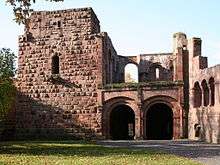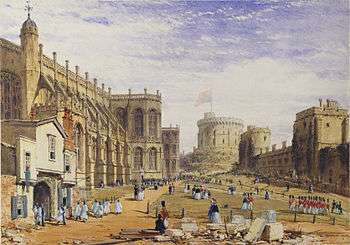Castle chapel


Castle chapels (German: Burgkapellen) in European architecture are chapels that were built within a castle. They fulfill the religious requirements of the castle lord and his retinue, sometimes also acting as a burial site. Because the construction of such chapels was expensive for the lord of the castle, separate chapels are not found at every seat of the nobility. Often a secondary room furnished with an altar had to suffice.
Castle chapels were usually consecrated to saints, especially those associated with knighthood, such as Saint George or Saint Gereon. In 1437, the chapel of Saint Mark at the castle in Braubach, Germany, gave the castle its present name: the Marksburg.
Frequently castle chapels were located near the gate or in the upper storey of the gate tower as, for example, at Wildenberg Castle in the Odenwald, in order to claim God's protection over the most vulnerable point in the castle.
Prominent examples are the double chapels at imperial castles and Kaiserpfalzen, for example the chapel of Nuremberg Castle. For services, the nobility were seated in their upper balconies and their retinue in the pews below. The design of the chapel stressed the differences in status.
Examples
Literature
| Look up castle chapel in Wiktionary, the free dictionary. |
| Wikimedia Commons has media related to Chapels of castles. |
- Barbara Schock-Werner (ed.): Burg- und Schloßkapellen. Kolloquium des Wissenschaftlichen Beirats der Deutschen Burgenvereinigung. Stuttgart 1995.
- Ulrich Stevens: Burgkapellen. Andacht, Repräsentation und Wehrhaftigkeit im Mittelalter. Darmstadt, 2003.
- Gerhard Streich: Burg und Kirche während des deutschen Mittelalters. Untersuchungen zur Sakraltopographie von Pfalzen, Burgen und Herrensitzen. Sigmaringen, 1984.
- Alexander Thon, Tina Rudersdorf: Burgkapelle, Kapellenerker und Tragaltar. Überlegungen zu einer Typologie des Sakralbereichs mittelalterlicher Burgen im Rheinland. In: Jahrbuch für westdeutsche Landesgeschichte. No. 25, 1999, ISSN 0170-2025, pp. 141−181.